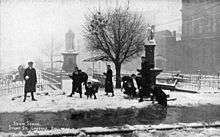Sturt Street Gardens
| Sturt Street Gardens | |
|---|---|
|
Aerial view of the eastern part of Sturt Street Gardens looking east | |
| Type | Public park |
| Location | Ballarat, Victoria, Australia |
| Coordinates | 37°33′40″S 143°50′59″E / 37.56111°S 143.84972°ECoordinates: 37°33′40″S 143°50′59″E / 37.56111°S 143.84972°E |
| Area | 2.87 hectares |
| Operated by | City of Ballarat |
The Sturt Street Gardens is a central reservation running along one of the main thoroughfares of Ballarat (Victoria, Australia) — Sturt Street — after which it is named. The formal gardens span 13 city blocks from Grenville Street in the east to Pleasant Street in the west, are 20 metres (22 yd) wide and cover an area of 2.87 hectares (7.1 acres) running east–west.[1]
The historic gardens are the main gardens of Ballarat's Central Business District and significant for their heritage features including significant statues, bandstands, memorials and trees. Three of the reserve's monuments are listed on the Victorian Heritage Register and the entire gardens are listed as a heritage precinct by the City of Ballarat.[1] The gardens are important to the culture of Ballarat.
Several blocks along the gardens have individual names based on their history and features such as Queen Victoria Square and Alexandra Square.
History
Sturt Street, the main boulevarde of Ballaarat, was created by the first survey of the town in 1851 by WS Urquhart. In the 1860s a dual carriageway with central median strip was created.
Victorian Heritage Register Sites
Titanic Memorial Bandstand

The SS Titanic Memorial Bandstand is an excellent and unusual example of creative bandstand design of the Edwardian period, a picturesque composition with dominant roofs of oriental character, it is an exotic and important element of the streetscape of Sturt Street.
Constructed in 1915, it is one of the few remaining examples of what was once a building type found commonly in the parks and gardens of many municipalities. It serves as a tangible reminder of a highly popular form of entertainment, prominent on the community agenda for many years. The construction of the bandstand and its survival until now also reflects the place of music in Ballarat's cultural identity and the continuing prominence of music in the community.
It is a memorial to the sinking of the RMS Titanic, a disaster still recalled today, and principally to her heroic musicians who played as they went down with their ship.
The bandstand and its construction is indicative of Ballarat's self-image and patriotic fervour.[2]
Queen Alexandra Bandstand
The Alexandra Bandstand is a typical and well resolved example of creative bandstand design; it polygonal form surmounted by a 'Moorish' onion dome is representative of bandstands of this period. The bandstand has particularly fine wrought iron detailing incorporating musical motifs and is an important and exotic element of the streetscape of Sturt Street.
Built in 1908 during the heyday of the band movement, it is now one of the few remaining examples of bandstands in Victoria. It serves as a tangible reminder of a highly popular form of entertainment, prominent on the community agenda for many years. The construction of the bandstand and its survival until now also reflects the prominence of music in Ballarat's cultural and civic identity.[3]
Statues
The City of Ballarat has a walk of the statues within the Sturt Street Gardens.[4]
The main statues in order from West to East are:
- Peterson Fountain 1923
- Mother Earth 1952 Sculptor: George H. Allen
- Peter Lalor 1893 Sculptor: Nelson McLean
- Sir Albert Coates 2000 Sculptor: Louis Laumen
- King George V Monument 1938 Sculptor: Victor Greenhalgh
- Ruth 1899 Sculptor: Charles F. Summers
- Hebe 1899 Sculptor: B. Raggi
- Thomas Moore 1889 Sculptor: George Grant
- Queen Victoria Memorial Fountain 1902, Sculptor: F. W. Commons[5]
- Queen Victoria 1900 Sculptor Sir Edgar Bertram MacKennal
- Robert Burns 1867 Sculptor: John Udny
- Point to Sky 2002 Sculptor: Akio Makigawa
- Perseus 1943
Memorials and monuments
- Gordon Memorial 1969, Sculptor: Raymond B. Ewers
- Cenotaph 1949, Architect: John P. Shimmin
- Eternal Flame 1995, Sculptor: Peter Blizzard
- Korean, Borneo, Malayan, Vietnam War Memorial 2000
- William Dunstan Victoria Cross Memorial 2000
- King George V Monument 1938, Sculptor: Victor Greenhalgh
- Phoenix Foundry Plaque
- Queen Victoria Memorial Fountain 1902, Sculptor: F. W. Commons[6]
- Boer War Memorial 1906, Sculptor: James White
- Burke & Wills Fountain 1867
- SS Titanic Memorial Bandstand 1915, Architect: G.W. Clegg
- Pioneer Miners Monument 1951
- James Galloway Monument 1880
Gallery
 Snow scene in Sturt Gardens in 1905.
Snow scene in Sturt Gardens in 1905. Boer War Memorial.
Boer War Memorial. Burke and Wills Fountain.
Burke and Wills Fountain. Thomas Moore Statue and the Ballarat Town Hall.
Thomas Moore Statue and the Ballarat Town Hall. Peter Lalor Statue.
Peter Lalor Statue.
References
- 1 2 Ballarat Open Space Strategy, Volume 1, City of Ballarat, Australia. March 2008.
- ↑ "Titanic Memorial Bandstand, Victorian Heritage Register (VHR) Number H0971, Heritage Overlay HO105". Victorian Heritage Database. Heritage Victoria.
- ↑ "Queen Alexandra Bandstand, Victorian Heritage Register (VHR) Number H0972, Heritage Overlay HO106". Victorian Heritage Database. Heritage Victoria.
- ↑ Trails and Tracks Brochure, Visit Ballarat, Australia.
- ↑ http://users.ncable.net.au/~jburrell/gen/hutchins/com_wil.html
- ↑ http://users.ncable.net.au/~jburrell/gen/hutchins/com_wil.html
External links
![]() Media related to Sturt Street Gardens at Wikimedia Commons
Media related to Sturt Street Gardens at Wikimedia Commons
